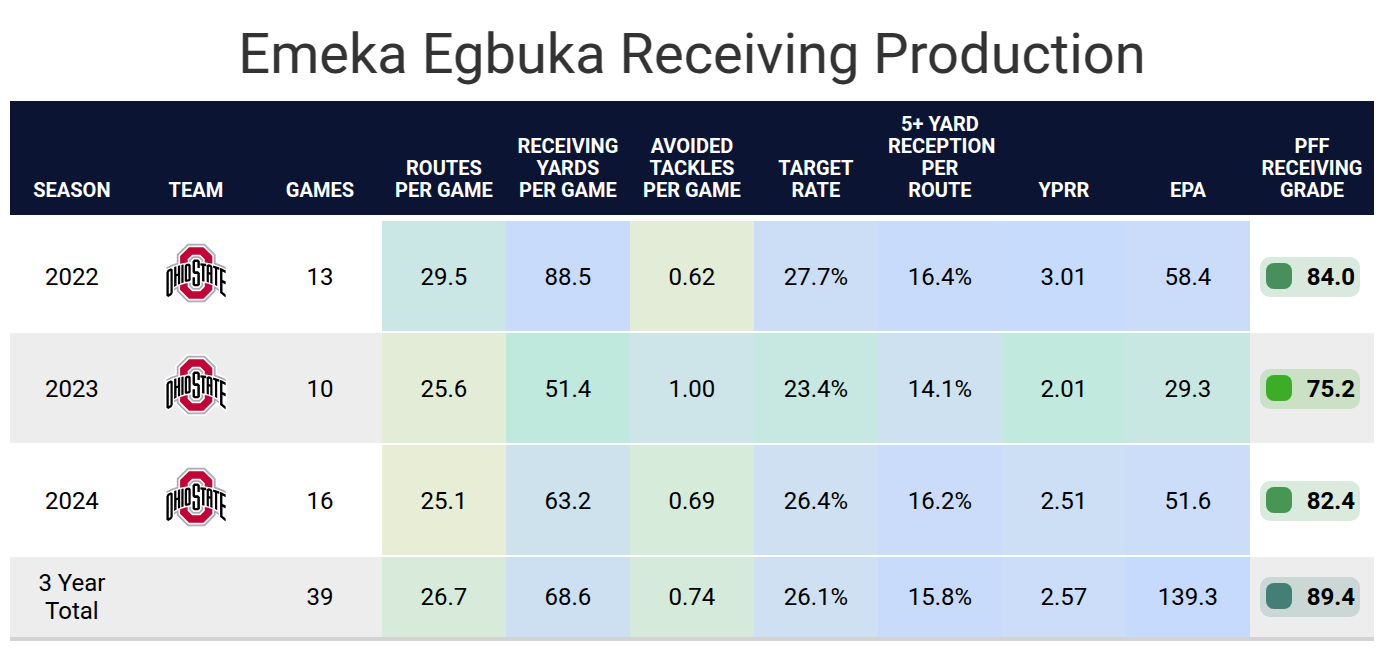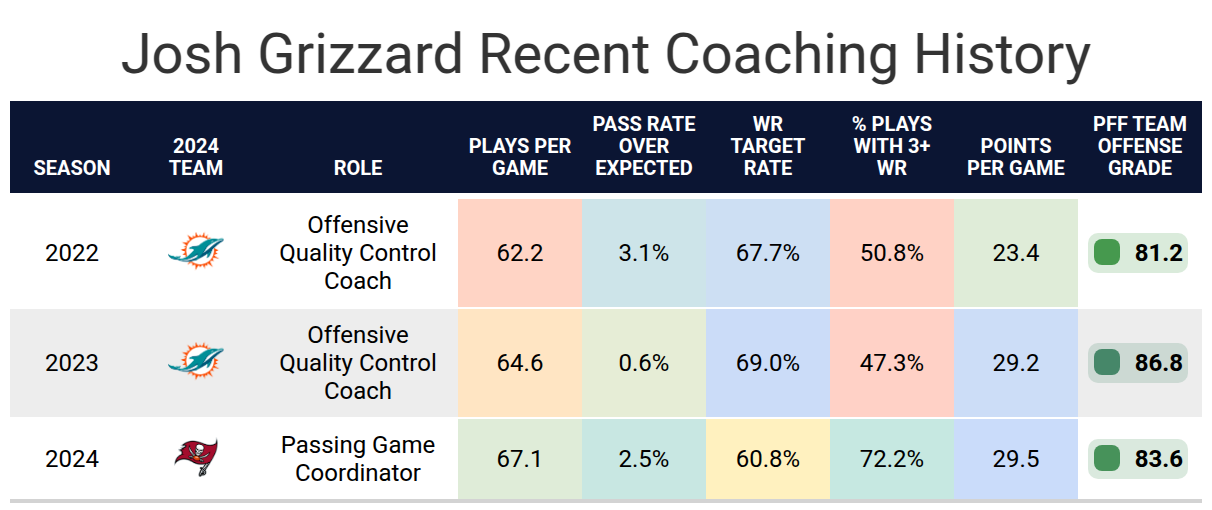- Emeka Egbuka could be the next great slot receiver: Some of the best slot receivers in recent seasons are on the backside of their career, opening the door for someone like Egbuka to stand out.
- When will Egbuka’s presence be felt?: The Tampa Bay Buccaneers wide receiver room is stacked, which could make it hard for Egbuka to see enough targets to be fantasy relevant early on.
- Final chance to claim 25% off PFF+: Use code DRAFT25 and unlock access to player grades, fantasy tools and the 2025 Draft Guide
Estimated Reading Time: 5 minutes

PFF’s Fantasy Football Player Profile series delivers the most in-depth fantasy football analysis available for the 2025 season.
Using PFF’s exclusive data, we evaluate player performance, competition for touches and how teammates and coaching staffs will impact each player's fantasy football outlook.
Last updated: 7:15 a.m. Tuesday, April 29
Click here for more draft tools:
NFL Draft Big Board | Mock Draft Simulator | NCAA Premium Stats
2025 PFF Draft Guide | Mock Draft Hub | Prospect Data Profiles
Draft Position Rankings
Player performance
Emeka Egbuka has spent the last three seasons as the second option in Ohio State’s passing game, first behind Marvin Harrison Jr. and second behind Jeremiah Smith. The Buckeyes are often ahead in games, allowing them to run the ball with future NFL running backs. This has hurt his cumulative statistics, but his per-route numbers are very strong relative to other wide receivers. His target rates remained extremely high for a No. 2 receiver.
Egbuka checks many boxes, including high separation scores and catch rates. While his speed isn’t elite, it’s what you would expect from a mid-to-late first-round pick for his size. On the downside, our draft guide notes his “route breaks could be sharper” and “his breaks aren’t as sharp or twitchy as some.” In general, you would hope players in college see their numbers improve each season, which wasn’t the case for Egbuka. Part of that is he played so well in his second year that there wasn’t as much room to improve as most receivers, but he also never exceeded an 85.0 receiving grade in a season like most other potential first-round wide receivers.


Projected role
Egbuka is projected to be a slot receiver, as he played nearly 75% of his snaps in the slot in college, but he could also possibly play the Z role.
If you ranked the teams that needed a wide receiver the most heading into the draft, the Buccaneers would be near the bottom of the list. They retained future Hall of Famer Mike Evans, were able to re-sign Chris Godwin, and 2024 third-round pick Jalen McMillan began to shine late in his rookie campaign. In order for Egbuka to play significant snaps in his most natural role as a rookie, he would need to beat out Godwin, who has been one of the most prolific slot receivers of the last decade and was a top wide receiver in fantasy points per game last season.
His cleanest path to playing time will be beating out McMillan for the Z receiver role. McMillan similarly played slot in college and moved out wide with Tampa Bay. Even if he beats out McMillan and takes the Z receiver role, there aren’t enough targets to go around. McMillan had a 14.8% target rate last season, which isn’t strong enough to be a fantasy starter. During the six games where Evans and Godwin were both fully healthy last year, all of the other receivers combined averaged just over four targets per game.
If no one in Tampa Bay is injured, it’s hard to imagine Egbuka becoming a fantasy starter in the near future. Even if Evans retires after the season, Godwin, McMillan and Egbuka are all more suited to be slot receivers or Z receivers rather than X receivers, making it challenging for the three to coexist. Both Godwin and McMillan will be on the roster for a minimum of two seasons.


Impact of teammates
The Buccaneers lost Liam Coen to the Jacksonville Jaguars, so Josh Grizzard, the team's passing game coordinator, was elevated to offensive coordinator. Grizzard has spent eight seasons in the NFL, mainly as a quality control coach with the Miami Dolphins. We can expect his offense to largely resemble the Buccaneers' last season, given its success, but this will be his first time in control of an offense. Because Grizzard inherited Evans and Godwin but was part of the regime that drafted Egbuka, it’s possible Egbuka becomes the top receiver of the offense, and the fantasy value for the other receivers gets destroyed.
Baker Mayfield was very successful in Coen’s offense last season. His accuracy was generally good relative to other quarterbacks on short passes and worse than the typical quarterback on deep passes, which works just fine for a receiver like Egbuka. Mayfield is also fine going off his first target more than most quarterbacks, which is also good for Egbuka, who might not be drawn up as many plays as other receivers, but will ideally get open when he’s on the field and catch Mayfield’s eye.


Bottom line
Egbuka was a very talented receiver out of Ohio State, but he was consistently the second wide receiver in Ohio State’s offense. With the Buccaneers, he will likely be the third option in the short term.
Footnotes
- Statistics in tables and charts were chosen based on their ability to predict future fantasy performance on a per-game or per-opportunity basis or to describe the player relative to others at the same position.
- “Opportunities” are defined as passing dropbacks, rushing attempts and routes run as a receiver.
- Numbers are provided either by season or based on the past three years. For rookies, only college statistics are included. For non-rookies, only NFL statistics are considered, regardless of whether they played in college within the previous three years.
- As college competition is easier than NFL competition, most rookies are likely to see a decline from their historical numbers.
- Only FBS data is considered for college players and comparisons.
- Kneel-downs are removed from rushing data to provide cleaner quarterback rushing rate statistics.
- The table colors in this article range from blue (indicating good/high) to red (indicating bad/low).
- All percentiles and color codings compare the given player to others with a high sample of opportunities. Generally, the cutoff is one-third of the possible opportunities in the sample. If a player does not meet the threshold, they are still included in the comparison, though their results may appear better or worse than expected due to the smaller, less predictive sample size.
- Information on utilization classifications and their importance can be found here for running backs, wide receivers and tight ends.



 © 2025 PFF - all rights reserved.
© 2025 PFF - all rights reserved.